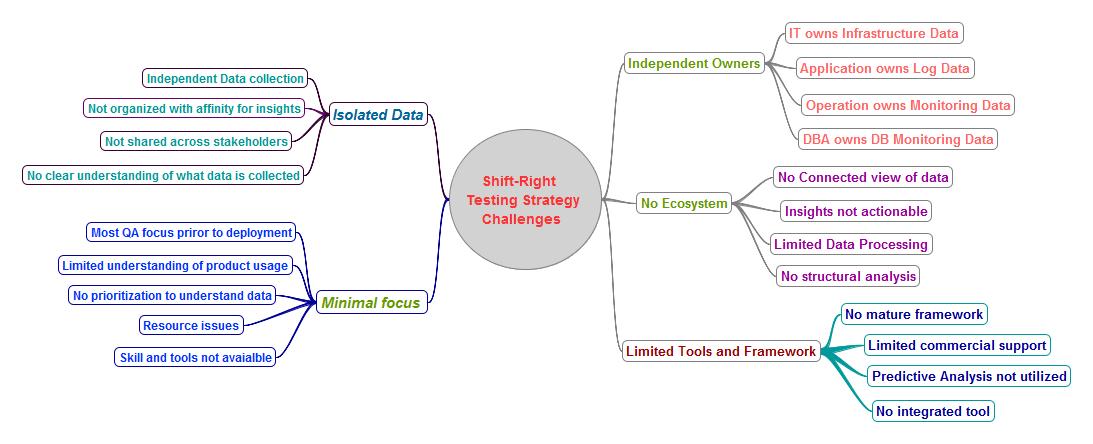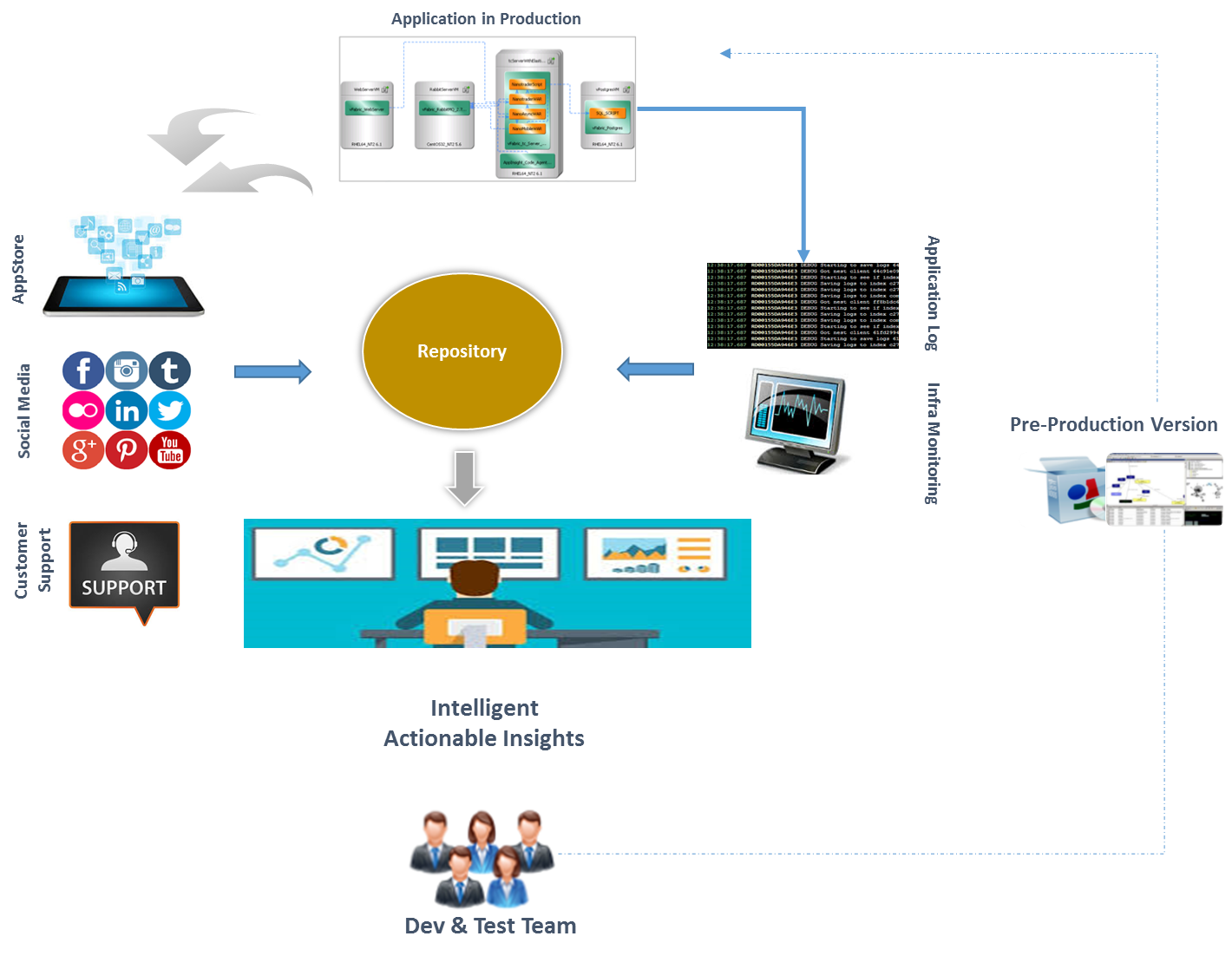Today, DevOps is increasingly becoming the way to develop, test, and operate. This warrants to build quality from the very beginning, starting with requirement gathering stage till deployment and operation. Speed and continuous delivery of software is key to survive in today’s changing ecosystem, business environment and customer needs. This propels the organisations to deploy patches, new features and enhancements in production frequently. Continuous delivery process demands:
- High-speed, iterative approach to software building
- Software with quality that is deployable throughout its lifecycle
- Automated deployment to production
- Continuous “Value Add” to customers
In an era of Continuous Delivery, it is important that we have continuous feedback and provide actionable intelligence to our development teams. This requires gathering and analysis of production application data related to performance, security logs, user interaction data, resource usage, customer feedback and perceptions. The ability to effectively analyze this data and provide actionable intelligence enable better quality, higher productivity and improved customer experience and retention. This focus on “Shift-Right” complements “shift-Left” strategy that focus on analysing software development.
Our Turbo Response Accelerator leverages big data analytics to harness intelligence from the data to get insights that can help development teams to take action. Our approach is predictive analytics based, and uses post release data for continually assessing the functional and non-functional qualities of the software in production, used by customers. Statistical techniques and algorithms identify patterns in the data and AI models are used to predict and define actionable intelligent insights for optimizing ongoing delivery.
Shift-Right Testing Perspectives
“Shift-Right” strategy focus on three major perspectives of software in use:
- Engineering and technical perspective
- Business or Value perspective
- Customer / Social perspective

As the software application is deployed in production, large volume of data is being generated by application logs, Application Performance Management tools and infrastructure resource monitoring tools. Data such as transactions, user load, response times, business process performance, application crashes, and security access logs enable us to get engineering and technical insights that are valuable to the teams if provided as an intelligent actionable item. Second, the tools provide data for business processes, features, regions, domains correlated to outcomes such as customer adoption, new leads/customer, and value and revenue generation. Data related to business process changes/enhancements correlated to business drivers such as support call reduction, self-service adoption, and incidents are useful to determine the effectiveness of change. Business value insights combined with the technical data analysis will provide the connected intelligence to understand the criticality and priority for the team. Lastly, valuable customer feedback data is available from social media platforms, app store reviews, forums and support requests. Data related to product defects, privacy and security, usability, liked features, unused features, Omni-channel experience feedback, and response time’s performance etc. are leveraged and integrated with engineering and business insights. Also, A/B Testing data from marketing campaigns and promotions, customer Net Promoter Scores data add valuable insights for the teams’ direction and road-map.
The key to successfully harnessing the valuable insights depends on creating an ecosystem that supports data collection and enrichment of data by appropriately building the affinity, real-time processing of data, statistical modelling and predictive analysis, converting the insights into intelligent actionable item and sharing them for execution.
Challenges
Organisations face many challenges in harnessing available insights from technical, business and customer data. This pose threat to achieve the desirable benefits from quality of software, value add outcomes and customer experience. There are many reasons why the organizations are not effectively utilize the available data to harness insights and act to improve quality, delivery performance and customer retention.

Inadequate focus on “Shift-Right” testing strategy could be costly to businesses as we are moving towards Continuous Delivery mindset. An appropriate approach and framework is needed to address this gap.
Critical Challenges to overcome are:
- Isolated data – today each of the shift-right perspective data is available in isolated islands and affinitized to infer insights.
- Independent Data Owners – the organization boundaries have restrictions to share the available data to collate and break the islands of control.
- No Ecosystem for “Shift-Right” perspectives data – a mechanism and framework is needed to collate the data at one place for creating affinity and apply modeling and predictive analysis.
- Minimal QA Focus – today the reality for QA teams prevent their focus towards the “Shift-Right” mindset as there is limited resource for this practice and are chartered to test and validate the product prior to deployment, and typically there is no visibility to QA Team on Very minimal how the product is used and what feedback is coming, once its deployed and delivered to production.
- Availability of commercial tools and framework – No or limited focus by vendors to tap this opportunity as there is no commercial product available to support “Shift-Right” testing strategy.
Also, the increasing adoption of frequent deliveries to production puts pressure on the testing and QA teams to redefine the strategies to assure quality prior to deployment. This opens opportunity to strategize towards “Shift-Right” mindset and exploring options to validate the product in production.
Solution – Turbo Response Accelerator
The dawn of Big Data and Data Science with Deep Learning and Artificial Intelligence enables us to process data with high speed at economical cost, and makes predictive analytics feasible. As we see the exploding of IoT and Machine Learning, many organizations deploy these technological advancement to maximize business value and outcomes.
As we build, deploy and operate software, lot of data is generated and not leveraged fully to maximize benefits and reduce risk in software development lifecycle process. By “shifting-right” and working with post-release data, information feedback from customers and production system monitoring data, we can get insights that can be utilized by software development lifecycle processes and organization to reduce risk and maximize value.
Our Turbo Response Accelerator adopts an approach to provide continuous intelligent insights to respond with actions, based on the real-time data gathered from multiple sources and organized them in such a way that respective role in SDLC can get specific and realistic insight. Data and sentiments are processed to predict patterns and focus on optimization of testing process. This enables pro-active testing based on usage patterns/feedback and reduces production service ticket volumes.
Following are some key insights that can be harnessed:
- Enabling testers to maximize testing impact by predicting error or failure prone components and modules of the application
- Engineers to recognize and identify defect patterns and defect heat maps / hotspots that helps in optimizing the process
- Enabling evolution and refinement of application by providing contextual feedback about the functional and non-functional issues
- Optimizing the delivery and business processes by providing the behavior based feedback on customer sentiment, application performance and business outcomes
- Enabling security team to optimize security practices by getting continuous data on application vulnerabilities and potential security hotspots
Encourages user-centric testing leveraging continuous monitoring data and customer behavior sentiments

Turbo Response Accelerator leverages big data components in acquiring the data from different sources, processing the data, categorizing against specific domains and drivers. Predictive Models and AI algorithms enables data analysis and inference. The outcome is actionable insight that is shared across the teams and roles to determine the right next steps. The dashboard and graphical representation of the data and associated action makes it simpler for the teams to adopt.
Conclusion
Today’s digital business environment demands efficient processes, optimized quality, quicker response to market demands and maximum return on investment. Also, increased adoption of DevOps and continuous delivery concepts in mainstream software delivery pushes the need for an ecosystem that supports continuous data collection, analysis, and getting valuable insight for immediate action that is accurate to address the issue at hand.
Turbo Response Accelerator provides this ecosystem powered by Deep Learning and AI to support the needs of the software engineering teams. By implementing this Accelerator, the teams are empowered with tools and methodology that supports User Feedback Centric Testing and enabling optimization of processes. Faster action to resolve customer issues helps in increasing the customer confidence and positive net promoter index.
